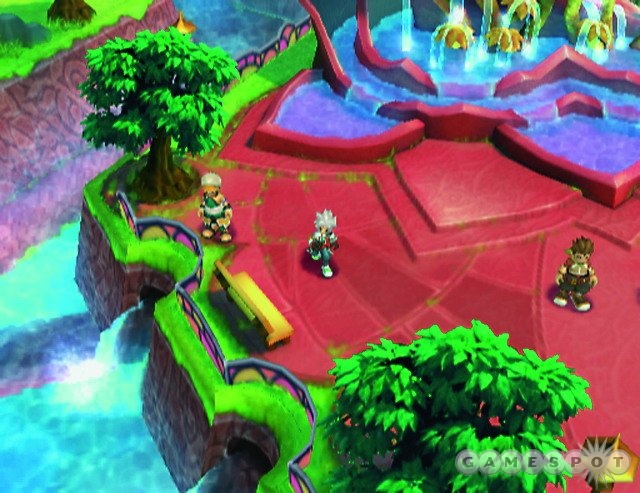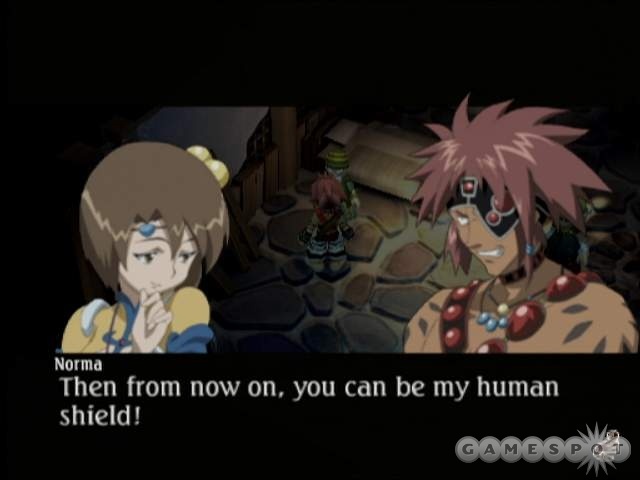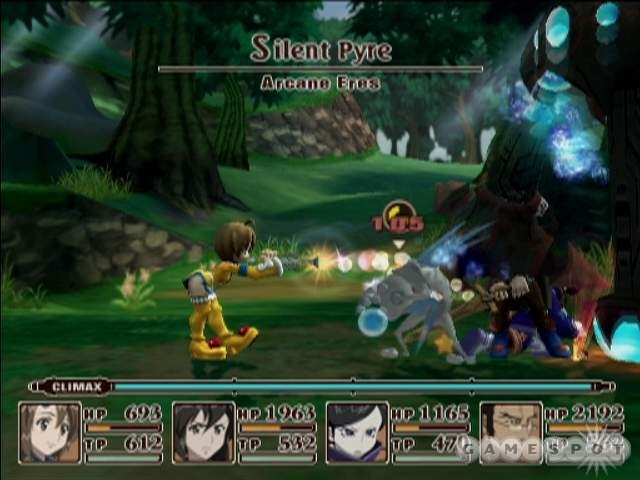Namco-Bandai's saga of "Tales" games have found homes on a variety of platforms over the years, with almost every entry spinning its own independent story in its own unique world. Tales of Legendia is the newest face in the Tales family, and there's a lot to like about it, from its rich and beautiful environments and easy-to-grasp battle system to its chatty and personable cast. Some blemishes exist, most prominently in the tuning of the encounter rate and how world travel is handled, but genre and series fans will find it easy to like this otherwise well-crafted adventure.

Getting into the story is initially a bit confusing. Senel Coolidge is a white-haired, serious-faced young man protecting his sister, the demure, soft-spoken Shirley. Both of them are on the run from enemies unknown, when their boat is suddenly overtaken by what appears to be a floating continent. The continent is actually a giant ship called the Legacy, an artifact from a civilization called the Kingdom of Terises that existed thousands of years in the past. Once Senel and Shirley board the Legacy, things start to happen very quickly: First, Shirley is exposed as having the ability to breathe underwater and glow mysteriously, marking her as a "Ferines," or one of the "people of the water." Secondly, she's thought by locals to be the "Merines," a legendary being who has the ability to pilot the Legacy. Thirdly, within five minutes of landing she's abducted by bandits, in proper heroine fashion. You'll eventually learn what all these names and races actually are, and why Shirley is so important to the future of the Legacy (and even the world), but you'll have to save her first.
One of Legendia's biggest strengths is its cast of characters, and that's because there's plenty of spoken and text-based interaction between your party members at almost every turn. Story sequences, short skits on the world map, and their constant calls to each other during and after battles all combine to give each character a fairly well-defined sense of self. There's Senel and his single-minded devotion to his sister; Chloe, a knight with a heightened sense of justice who fights to redeem her family name; Norma, a grabby little treasure-hunter and overall pest; and Will, a scholar turned law-enforcement official on the Legacy who fights to keep everyone in line. These and other characters are defined largely by their speaking roles, and the sizeable amount of speech is uniformly excellently done.
Part of what makes Legendia's already somewhat chaotic battles fun, in fact, is all the shouting your party does, chanting spells and naming attacks, in addition to calling to each other about enemy special moves. The battle system is real-time, placing characters and enemies in a straight 2D plane where they can freely move about and whack each other. Typically, you'll only control one character at a time; the other three members of your party have malleable artificial intelligence and settings, to the point where leaving them to their own devices works out just fine. You can even change settings for the leader character to be automatic, but you'll want to be running around and causing mayhem yourself. All your party members use a power called eres, which either grants them melee attacks or powerful magical spells, and which cost tech points to cast. Each character learns a variety of eres as you go along, each new skill even more powerful (and more impressive looking) than the last. However, the hardest-hitting skills aren't necessarily the only ones you'll ever use, thanks to the combo system.

Combos are initiated by striking a single foe multiple times, either by a single character or a number of characters working together. The window for combos isn't overgenerous, as you'll need to strike the enemy in quick succession to keep the combo going, but there are a number of advantages to chaining them as high as you can. You get an experience bonus based on the chain amount and the overall damage you inflict, and you can charge up a "climax" meter, which when full lets you stop time for the enemy and unload damage within a set duration. However, the most important function of combo attacks is that pummeling foes with hits will delay their special attacks and spellcasting, if not cancel them all together. It's key to surviving boss fights, where instead of wanting to dump all your points into single, powerful hits, you'll want to use eres that strike over and over again, to use in concert with your party's similar abilities to extend interrupts as long as possible. In fact, if you can position yourself and a party member on opposite sides of a foe, combo-smashing can completely nullify most any action for extended periods. This is pretty amusing, though once you've figured out how to use combos to your advantage, battles of any sort become much, much easier.
Having the battles be easy works out, because there are so many of them. Tales of Legendia has a random encounter system that's very frequently used. This isn't something that's all that uncommon in RPGs, and it's something that RPG fans are pretty used to at this point, but the high rate is coupled here with dungeon zones composed mostly of long, winding paths that frequently double back and run parallel to each other. The areas are often lovely to run through, but they also feel constructed specifically to cause you to run into a high number of monsters as you travel, and it can easily deflate even the most patient of gamers. To the game's credit, it does pepper dungeons with multiple treasure chests to make the journey a little sweeter.

Moving around on the world map suffers from similar issues--you seem to move especially slowly overland, and while you can rotate your camera freely, you can't change the pitch, so your view around yourself is pretty narrow. Since your world map displays only extremely faint topographical information, you're left watching your minimap and hoping that you just went on the correct side of that long mountain range. Fortunately, every area you'll visit has a "duct" outside that will teleport you to the Legacy's main city and back again should you need supplies or to travel home, so you'll never run to the same place twice.
Not that you wouldn't want to visit some areas multiple times. While the 3D character and overworld art is relatively simple, the many different locales in the game have a very slick look to them, with rich colors and nice details. The Legacy itself has a sort of floral theme, so in addition to the red sandstone flower fountain in its capital city of Werites Beacon, many other areas are touched with the same hue and designs in subtle or overt ways. The many ruins, caverns, citadels, and even city squares each have their own character, from crystal forests to lava caverns. Another graphical standout are the many eres effects you'll use over the course of the game, which get increasingly impressive as you learn more powerful spells and moves. The enemies you use them on don't look too shabby either; while certain monster types are repeated, the new varieties often go past simple palette-swapping, with energy and element effects and strong new powers. Most story sequences are punctuated by character portraits, and a few animated cutscenes help flesh out the plot development visually.
The great voice acting is ably matched by Legendia's music, much of which is orchestral in nature and contains some very nice themes. In particular, the theme to the city of Werites Beacon, with its lilting female vocals and peaceful tone, is always soothing. There's perhaps not a huge variety of music, but select themes are very memorable and settle in just fine alongside the more standard fare battle music and sound effects.

You can clear the main narrative of Tales of Legendia in just shy of 30 hours, but in an interesting move, that's not really "the end," so to speak. When you finish the main game, you'll be able to go on a series of character quests, essentially tying up all the various storylines of your cast of party members, things that were hinted at in the first portion of the story but never resolved. These quests do a great job of filling out the rest of the game, providing an alternative approach to an "ending" as well as easily bringing your game time up to 40 hours or more as you battle through some of Legendia's toughest content. In addition, a whole new item-creation system opens up in the second part of the game, letting you manufacture powerful weapons and other items. When you consider that the regular game already has a whole cooking minigame (finding Mimi the Wonder Baker hiding on the battlefield with a delicious recipe is always amusing), as well as a number of "titles" that you can earn for your character, the game's value holds up well.
Tales of Legendia is an easy recommendation for those who enjoy Japanese role-playing games; the battles are fast-paced and enjoyable, the story moves along enough to be interesting, the characters are personable, and the whole package is very well-polished and pretty to look at. If you're the type of person who loathes frequent random encounters, this isn't going to be the game that changes your mind, but if you don't have a problem punching monsters in the teeth a whole lot, definitely give Tales of Legendia a shot. It may be on the formulaic side, but it's still an engaging journey.